For those of you who just want to know the results, here they are:
tl;dr 1 card in hand = 1 card on the field = 2 cards in gauge = 2 life = 2 damage
Now that you know, you can start making decks that are actual advantage-based instead of whatever you felt like running. But most people probably had something similar in mind to this as they were building decks. At least Bushiroad did.
For those of you who want to know the entire process that went into this, then here we go!
1 Card in Hand = 1 Card on Field
In other words, what field advantage equates to in BF.
This was a long-debated idea, and I was almost certain that a card on the field was worth 1.5 cards in the hand (that way you could justify cards that were overcosted just to return cards to hand). Unfortunately, the math didn't add up, so cards on the field are just worth cards in the hand. It ends up working because the card can attack, which is what technically generates damage advantage (more on that later). Common sense, really, in other card games it's this way as well.
However, Buddyfight introduces an interesting mechanic that actually changes this up a bit. When you place a card on the field, you undergo a -1 card in hand/+1 card on field transaction that is essentially a wash except when you place a card in the center. Then you actually gain an additional point of field advantage for a total of -1/+2. I'll explain.
When you place a card in the center, you are not only using that card for attacking purposes, but also as a direct shield for your life. Your opponent (usually) has no way of damaging you without removing whatever is in your center column, no matter what card it is. Whether it's a Duel Sieger incarnation or a flimsy Armorknight Tiger, your opponent has to figure out a way to remove that card before getting to you.
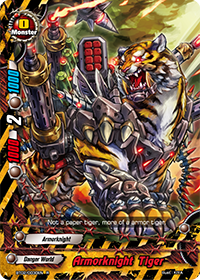 |
| Lit. Paper Tiger |
However, if they used a spell or an ability to remove that card, not only do you lose the card but the opponent gains a +1 field advantage via removal. This is an important note to remember. The +1 extra field advantage gained from placing a monster in the center only applies if your opponent must attack in order to destroy it. If they destroy it via other means that do not take up an attack, then they "steal" the advantage point back, making it even. Therefore, it is always advised to place monsters in the center to guard and to use removal spells and abilities on monsters in the opponent's center area. Playing by this rule is the first step to beating your opponent in the advantage game.
1 Card = 2 Life
Remember this terrible card that came with not the Trial Decks but the STARTER KITS that were passed around for free? Yeah, it at least establishes the equation for us, which is about its only contribution to the entire game as a whole.
"But why Blaise would you use such a crappy card to determine the advantage equation?"
Good question. It's because there are other cards that do, in fact, confirm this (besides Dragonic Heal).
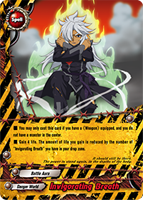 |
| *Gasp |
1. Ever card in your discard pile decreases the heal by 1. Okay, so after you use it once it loses effectiveness. 1 card for 3 life is still a plus in my book, and 1 for 2 is dead even. Running any more than 3 of this card in a deck is pretty stupid. Not only that, but if you accidentally discard this card via gauge, your heal amount decreases even if you didn't actually use the card. Remember that.
2. More importantly, you must have a weapon equipped and no monster in the center. Wow. So the monster part is easily avoidable since you can just cast this THEN play a monster. And Danger World is built around weapons, right? So that shouldn't be too bad...except. What is a weapon? A card. And there you have it. In order to heal 4 life, you must commit 2 cards to do so. There is no way around it.
Of course the weapon isn't just discarded, it can be used for awesome Danger World stuff later, so Invigorating Breath is still an amazing card. Nevertheless, it is balanced fairly in terms of healing potential. Not broken whatsoever.
Ancient World gets a 1 card = heal 3 because Bushiroad felt sorry for their Lifelink cards getting crapped on by all the Magic World removal out there.
1 Card = 2 Damage
This makes sense. Think about it, what is the most common critical number out there? 2. Every fairly balanced Size 1 monster has 2 critical. If they have subpar stats like Gaelcorga then they get an extra critical to balance out the stats; on the other hand, if their stats are godly (Armorknight Hellhound) then they get hit in the critical/damage area. Size 2's and 3's share a common trend (Jamadhar Dragon vs. Extreme Sword Dragon and Armorknight Griffin vs. Armorknight Golem).
 |
| Lizard-in-boots |
Nothing shows this better than Twin Horn Dragon, Ark Giraffa. For -1 from hand and -2 gauge, it has the ability to Double Attack with 2 crit for a total of 4 damage. If you notice, his stats are the reverse of Armorknight Chimera so his 2 gauge call cost pays directly for Double Attack. I'm getting a little ahead of myself by already assuming that damage = gauge (bad Blaise, bad!) but it goes to show that this card is completely sensible.
1 Life = 1 Damage
Seriously.
1 Card = 2 Gauge
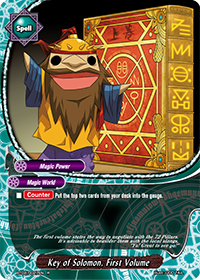 |
| A muppet? |
Now, people are complaining that these cards are "bad". Well, yeah, mostly. I personally wouldn't recommend any of them unless your deck runs exclusively on gauge (usually Key of Solomon is the most used out of them). Forcing yourself to top-gauge the cards instead of choosing which card to gauge is also a huge disadvantage. So why would the 1 card for 2 gauge equation still hold if the trade is in fact a disadvantage?
The answer is in the damage. Damage and gauge are interchanged almost perfectly as a wash transaction. Saberclaw Dragon, Valken sports the "Beast Aura" ability that exchanges gauge for life whenever it's called to the side. Night in the Wild gives you the ability to perform this wash indefinitely, albeit once per turn only.
Dragon World has Dragoknuckle that converts life to gauge on-hit, which means that Dragoknuckle is a minus until it hits at least once (which is extremely good for a weapon and makes it a very pressuring one). Death Sickle Dragon, similar to Ark Giraffa, gives Double Attack for 2 gauge. Inferno Armor Dragon is ideally a 2 gauge for 1 card on-call. His additional ability is what makes him a plus. There's also Rising Flare Dragon, who exchanges 2 gauge for the ability to remove a card from the field, further exemplifying this equality.
Gunrod, Bechstein is a -1 card -1 gauge for the ability to deal 1 damage to your opponent every turn. 3 turns and it's a wash, then every turn after that is free damages. Stradivarius takes one more turn to even out, but you get to give power to your units simultaneously which is nice. Center of the World, Mary Sue (aka Bloody Mary). 2 gauge gives you the ability to tutor a spell, which is insane.
Great Duke, Astaroth is another well-balanced card. His soulcharge from hand is a wash, and the 3 gauge of his on-call is balanced out with Double Attack (2 damage = 2 gauge) and his ability to reduce spell costs by 1 gauge - using one costed spell is enough to justify his call (though since he soulcharges from hand he's not that great after all).
Flash-strike Ninja, Zanryu is a Promotional card (PR) that costs 2 gauge on-call. His stats don't justify it, so we expect the 1 advantage to be generated from his skill. Unfortunately, his skill costs even more to activate: -1 card from hand and -1 life. The result? The attack is nullified and the card is destroyed. Remember what I said about 1 attack being equal to 2 damage? That comes into play here - you gain a +1 from nullifying the attack, a further +1 from destroying the card for a total of +2. If you do this once, you only take a -0.5 in overall advantage that includes calling him. Since you can do this multiple times, it's not a bad trade-off. If your opponent leaves him alone, then he's a great 3 crit pressure column.
Ancient World gives us Dimensional Demonic Dragon, Ladis the Tyrant (screw you Duel Sieger). His call cost of 3 gauge is balanced with his Double Attack of 3 crit/damage (he's actually +0.5 overall just on-call). He can then discard 1 card and take -2 life to perform essentially a Soulguard. -2 for +1? Umm, no. He can discard 1 card and instead pay 2 gauge to nullify a spell and destroy it (essentially). This sounds much better. The call cost of the spell is negated since both require -1 from hand. It's up to the user to justify whether the effect of the enemy spell is worth a -2 gauge.
Finally, from the Generic world, we have Actor Knights the Magician. I personally love this card. Crap stats that only deserve to be put into the center as a paper shield. His reasoning goes like this: you can put him in the center and poke your opponent for 1 damage. Then, when he get's destroyed, pay 1 gauge to draw 1 card. +0.5, -0.5 and +1. He pays for himself! And you get a shield for a turn. Of course, his ugly numbers justify the free advantage, but he's an interesting and useful tech in any deck (though Magic World has Glassart who is much more intimidating).
And that's that. Hopefully by reading this you'll have a better understanding about how the basic advantage math works in Buddyfight. It's not a balanced game by far (damn you Drum) but it has it's "vanilla standards" as I like to call them, baselines that every deck should strive to be on average. If you can beat the advantage standard, you can win the game. Of course, not everything is covered in this article. There's still the cost of Penetrate (which is goddamn broken) and how direct damage is actually calculated differently from attack damage (and no, it's not 1 card for 1 damage you Trans-flame bursters). And what about power and defense? Well, they have their math too, but that's for another article entirely.
After all, your best Buddy is probably a statistics book and a TI-84 calculator.
This card advantage discussion continues in Field Control, Magic Numbers, and finally Abilities and Direct Damage.
 |
| Bushiroad has a fetish for restanding cards |
Gunrod, Bechstein is a -1 card -1 gauge for the ability to deal 1 damage to your opponent every turn. 3 turns and it's a wash, then every turn after that is free damages. Stradivarius takes one more turn to even out, but you get to give power to your units simultaneously which is nice. Center of the World, Mary Sue (aka Bloody Mary). 2 gauge gives you the ability to tutor a spell, which is insane.
Putting it all together
I'll give a few examples of cards that put this advantage equation all together to create very well-balanced cards in every regard...and some that just screw this delicate balance all up.
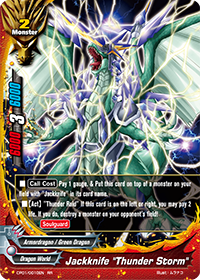 |
| NARUKAMI |
Let's start with the more balanced of the iconic dragons (because Drum is broken as hell, advantage-wise), Jacknife Dragon. His 1 gauge to call is justified by his decent stats and that extra crit. He can further pay 2 gauge to upgrade himself into one of his "evolved" forms. Since he goes into the soul of the new Mega Jacknife Dragon, it is essentially paying 2 gauge for an extra card. Advantage-wise, Jack is perfectly fine.
The famous Dragon shields are not. By simply using them to block ANY 2 damage attack, you are initiating a flat wash - anything greater than that is a plus (except White Shield, which is only situationally useful). In addition, they each have an added benefit of +0.5 either to life or to gauge. No wonder the standard is 4 Green 4 Blue in each deck: these things generate advantage like no other.
 |
| 20% cooler than Gao |
Ah, the famous Gargantua Punisher. Is it broken? Yeah. 4 gauge for 4 damage is an even trade-off (it's direct damage but screw that for now). You are therefore paying the price of 1 card to win the game. Given the right circumstances (which are not that hard to accomplish, really). Yeah. Like what the hell, Bushiroad.
Armorknight Demon. What a baddie. For a net -2 (-1 card from field, -2 gauge) you can Double Attack with a 3 crit monster. Normally calling the card should net 1 attack = 2 damage, so the other 4 damage comes from the call cost of the card. Remember, placing the card down is a wash but the attack is what generates the first +1 advantage (+2 damage).
Great Duke, Astaroth is another well-balanced card. His soulcharge from hand is a wash, and the 3 gauge of his on-call is balanced out with Double Attack (2 damage = 2 gauge) and his ability to reduce spell costs by 1 gauge - using one costed spell is enough to justify his call (though since he soulcharges from hand he's not that great after all).
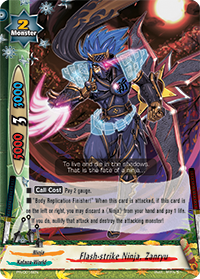 |
| Kakashi anybody? |
Ancient World gives us Dimensional Demonic Dragon, Ladis the Tyrant (screw you Duel Sieger). His call cost of 3 gauge is balanced with his Double Attack of 3 crit/damage (he's actually +0.5 overall just on-call). He can then discard 1 card and take -2 life to perform essentially a Soulguard. -2 for +1? Umm, no. He can discard 1 card and instead pay 2 gauge to nullify a spell and destroy it (essentially). This sounds much better. The call cost of the spell is negated since both require -1 from hand. It's up to the user to justify whether the effect of the enemy spell is worth a -2 gauge.
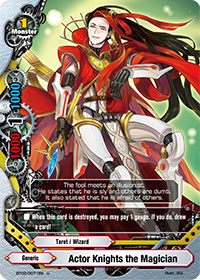 |
| Scarlet Swagmaster |
And that's that. Hopefully by reading this you'll have a better understanding about how the basic advantage math works in Buddyfight. It's not a balanced game by far (damn you Drum) but it has it's "vanilla standards" as I like to call them, baselines that every deck should strive to be on average. If you can beat the advantage standard, you can win the game. Of course, not everything is covered in this article. There's still the cost of Penetrate (which is goddamn broken) and how direct damage is actually calculated differently from attack damage (and no, it's not 1 card for 1 damage you Trans-flame bursters). And what about power and defense? Well, they have their math too, but that's for another article entirely.
After all, your best Buddy is probably a statistics book and a TI-84 calculator.
This card advantage discussion continues in Field Control, Magic Numbers, and finally Abilities and Direct Damage.
All images used obtained from the official Bushiroad website and used here solely for reference purposes. Future Card Buddyfight!, logos, and respective content belong to Bushiroad. Large images belong to the Buddyfight! Wikia.

This...is...brilliant....
ReplyDeleteBeing able to calculate all of this and make it easy to understand. I still cant even do algebra but this?
And I love how you made into numbers to match like 2 gauge= one card.
thanks a lot Blaise ^_^ starting out i have headaches trying to figure out if I should charge or not, attack side or opponent, which enemy monster is more threatening, link attacking... urgh... but your work makes it all the more understandable and therefore fun
ReplyDeleteI'm gonna make an unofficial world based on this info, it's going to be powerful but balanced therefore fair and fun
ReplyDelete